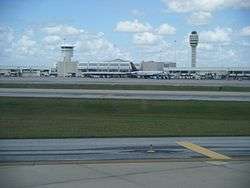Orlando International Airport
| Orlando International Airport | |||||||||||||||||||||||
|---|---|---|---|---|---|---|---|---|---|---|---|---|---|---|---|---|---|---|---|---|---|---|---|
 | |||||||||||||||||||||||
|
View of a terminal as seen from an arriving plane with the control tower in the background | |||||||||||||||||||||||
|
IATA: MCO – ICAO: KMCO – FAA LID: MCO – WMO: 72205 | |||||||||||||||||||||||
| Summary | |||||||||||||||||||||||
| Airport type | Public | ||||||||||||||||||||||
| Owner/Operator | Greater Orlando Aviation Authority | ||||||||||||||||||||||
| Serves | Orlando, Florida, U.S. | ||||||||||||||||||||||
| Hub for | |||||||||||||||||||||||
| Focus city for | |||||||||||||||||||||||
| Elevation AMSL | 96 ft / 29 m | ||||||||||||||||||||||
| Coordinates | 28°25′46″N 81°18′32″W / 28.42944°N 81.30889°WCoordinates: 28°25′46″N 81°18′32″W / 28.42944°N 81.30889°W | ||||||||||||||||||||||
| Website | orlandoairports.net | ||||||||||||||||||||||
| Maps | |||||||||||||||||||||||
 FAA airport diagram | |||||||||||||||||||||||
 MCO  MCO Location within Florida/United States | |||||||||||||||||||||||
| Runways | |||||||||||||||||||||||
| |||||||||||||||||||||||
| Helipads | |||||||||||||||||||||||
| |||||||||||||||||||||||
| Statistics (2015) | |||||||||||||||||||||||
| |||||||||||||||||||||||
|
Source: Aircraft operations: Federal Aviation Administration[2] Passengers: Airports Council International[3][4] | |||||||||||||||||||||||
Orlando International Airport (IATA: MCO, ICAO: KMCO, FAA LID: MCO)[5] is an international airport six miles southeast of Orlando, Florida, United States. The airport is the 2nd busiest in the state of Florida, as over 40.2 million passengers were handled at the airport as of 2015.[6] This makes it the 14th busiest airport in the U.S. by total passenger traffic.
The airport serves as a hub for Silver Airways, as well as a focus city for Frontier Airlines, JetBlue Airways, and Southwest Airlines. Southwest Airlines is the airport's largest carrier by passengers carried. The airport also is a major international gateway for the mid Florida region, with flights by foreign air carriers.
The airport code MCO stands for the airport's former name, McCoy Air Force Base, a Strategic Air Command (SAC) installation, that was closed in 1975 as part of a general military drawdown following the end of the Vietnam War.
In terms of commercial airline service, the Greater Orlando area is also served by Orlando Sanford International Airport (SFB), and more indirectly by Daytona Beach International Airport (DAB), Melbourne International Airport (MLB), and Tampa International Airport (TPA).
History
Military years
- See also: McCoy Air Force Base
The airfield was originally constructed as a U.S. Army Air Forces facility and military operations began in 1942 as Orlando Army Air Field #2, an auxiliary airfield to Orlando Army Air Base, which is now known as Orlando Executive Airport. Orlando Army Air Field #2 was renamed Pinecastle Army Airfield in January 1943. At the end of World War II, Pinecastle was briefly used for unpowered glide tests of the Bell X-1 from B-29 aircraft before the program moved to Muroc Army Airfield in California– now Edwards AFB – for the world's first supersonic flight. With the establishment of an independent U.S. Air Force in 1947, the airfield was briefly placed in caretaker status, until being reactivated during the Korean War as a Strategic Air Command (SAC) facility for B-47 Stratojets and KC-97 Stratofreighters and renamed Pinecastle AFB.
In the 1950s, the base began hosting SAC's annual Bombing and Navigation Competition. A B-47 Stratojet crashed during the 1958 competition, killing Colonel Michael Norman Wright McCoy, commander of the 321st Bombardment Wing, which was the host wing for Pinecastle AFB. The following year the base was renamed for McCoy. The base later was home to the 306th Bombardment Wing operating the B-52 Stratofortress and the KC-135 Stratotanker. It was also used by EC-121 Warning Star early warning aircraft of the 966th Airborne Early Warning and Control Squadron, a tenant unit at McCoy assigned to the Aerospace Defense Command.
During the Cuban Missile Crisis in October 1962, McCoy AFB became a temporary forward operating base for more than 120 F-100 Super Sabre and F-105 Thunderchief fighter bombers and the primary base for U-2 reconnaissance aircraft flying over Cuba. One of these U-2s was shot down by Soviet-operated SA-2 Guideline surface-to-air missiles near Banes, Cuba. Its pilot, Major Rudolf Anderson, Jr., USAF, was the crisis' only combat death. Following the crisis, McCoy AFB hosted a permanent U-2 operating detachment of the 100th Strategic Reconnaissance Wing until 1973.
McCoy AFB was identified for closure in early 1973 as part of a post-Vietnam reduction in force. The following year, McCoy's 306th Bombardment Wing was inactivated, its B-52D Stratofortress and KC-135A Stratotanker aircraft reassigned to other SAC units and most of the McCoy facility turned over to the city of Orlando by the General Services Administration (GSA) in late 1974 and early 1975.
Civil-military years
In the early 1960s, when jet airline flights came to Orlando, the installation became a joint civil-military facility.
Early jetliners such as the Boeing 707, Boeing 720, Douglas DC-8 and Convair 880 required longer and sturdier runways than the ones at Herndon Airport (now Orlando Executive Airport). Nearby lakes and commercial and residential development made expansion impractical, so an agreement was reached between the city of Orlando and the U.S. Air Force in 1962 to use McCoy AFB under a joint arrangement. The military offered a large AGM-28 Hound Dog missile maintenance hangar and its associated flight line ramp area in the northeast corner of the field for conversion into a civil air terminal. The city would then cover the cost of building a replacement missile maintenance hangar on the main base's western flight line. The new civil facility would be known as the Orlando Jetport at McCoy and would operate alongside McCoy AFB. This agreement became a model for other joint civil-military airports in operation today.[7][8]
Airline flights to the Orlando Jetport began shortly after an agreement was signed by the city and USAF in October 1961.[9][10] Over the next few years airline flights shifted from the old Herndon Airport (renamed in 1982 as the Orlando Executive Airport (IATA: ORL, ICAO: KORL, FAA LID: ORL)). In 1971 scheduled airlines were Delta Air Lines, Eastern Air Lines, National Airlines and Southern Airways.
When McCoy AFB closed in 1974/1975, part of the facility stayed under military control to support Naval Training Center Orlando.
There are only a few enclaves on the original McCoy AFB site that the military still uses such as the 164th Air Defense Artillery Brigade from the Florida Army National Guard in the former McCoy AFB Officers Club complex, an Army Reserve intelligence unit in the former SAC Alert Facility, the 1st Lieutenant David R. Wilson Armed Forces Reserve Center supporting multiple units of the Army Reserve, Navy Reserve and Marine Corps Reserve that was constructed in 2002, and a large Navy Exchange for active, reserve and retired military personnel and their dependents.
Civil-only years
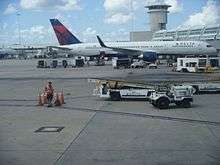
In 1975, the final Air Force contingent departed McCoy and the Greater Orlando Aviation Authority (GOAA) was established as a state-chartered governmental agency and an enterprise fund of the city of Orlando. GOAA's mission was to operate, manage and oversee construction of expansions and improvements to both the Orlando International Airport and the Orlando Executive Airport. The airport gained its current name and international airport status a year later in 1976, but retained its old IATA airport code MCO and ICAO airport code KMCO.
The airport became a U.S. Customs Service Foreign Trade Zone (FTZ) in 1978, said zone being designated as FTZ #42. In 1979, the facility was also designated as a large hub airport by the FAA based on flight operations and passenger traffic.
In 1978, construction of the current Landside Terminal and Airsides 1 and 3 began, opening in 1981. The original International Concourse was housed in Airside 1 and opened in 1984. Funding to commence developing the east side of the airport was bonded in 1986, with Runway 17/35 (now 17R/35L) completed in 1989. Airside 4 opened in 1990 and also contains an International Concourse for the processing of international flights. Airside 2, which filled out what will become known as the North Terminal complex, was completed in 2000, with the last additional gates added in 2006. Runway 17L/35R was opened in 2003, providing the airport with a total of four runways.
In 1978, MCO handled 5 million passengers. By 2000 that number had risen to 30 million. Today MCO covers 54 square kilometers (20.8 sq mi) and is the fourth-largest airport in the United States by area after Denver International Airport which covers 136 square kilometers (52.4 sq mi) of land area, Dallas-Fort Worth which covers 70 square kilometers (26.9 sq mi), and Southwest Florida International Airport (Fort Myers) which covers 55 square kilometers (21.2 sq mi). MCO has North America's second tallest control tower, replacing two earlier Air Force and FAA control towers.
MCO was a designated Space Shuttle emergency landing site. The west-side runways, Runway 18L/36R and Runway 18R/36L, were designed for B-52 Stratofortress bombers and due to their proximity to NASA's John F. Kennedy Space Center, were an obvious choice for an emergency landing should an emergency "return to launch site (RTLS) attempt to land at KSC fall short. The runway is also an emergency divert site for NASA's Boeing 747 Shuttle Transport Aircraft when relocating orbiters from either west coast modification work or divert recoveries at Edwards AFB, California or the White Sands Missile Range, New Mexico.[11]
Eastern Air Lines used Orlando as a hub during the 1970s and early 1980s, and became "the official airline of Walt Disney World." Following Eastern's demise, Delta Air Lines assumed this role, although it later pulled much of its large aircraft operations from Orlando, and focused its service there on regional jet flights, specifically with Atlantic Southeast Airlines, Comair and Chautauqua Airlines – all part of the Delta Connection system. All Delta Connection service ended September 30, 2008. After the merger with Northwest Airlines, Delta Connection service to Grand Rapids started. Delta Connection service to Raleigh/Durham also started and service to Miami began on March 27, 2011, but service to Miami has since ended. In recent years, Delta Air Lines has increased its service at Orlando to many places around the U.S., as well as seasonal service to Cancun, Mexico.
On February 22, 2005, MCO became the first airport in Florida to accept E-Pass and SunPass toll transponders as a form of payment for parking. The system allows drivers to enter and exit a parking garage without pulling a ticket or stopping to pay the parking fee. The two toll roads that serve the airport, SR 528 (Beachline Expressway) and SR 417 (Central Florida GreeneWay), use these systems for automatic toll collection.
In October 2006, MCO opened a 100-space Cell Phone Parking Lot for drivers to use while waiting for passengers to arrive. The lot is set up as a free Wi-Fi Hotspot, enabling drivers to use their mobile devices to access the Internet, check e-mail, and monitor flight status. Around the same time MCO opened an Express Pickup service at each terminal allowing drivers to park their vehicles temporarily at a secure location just outside the baggage reclaim area in order to meet their arriving party in person. A fee is charged for this service and is only available to E-Pass and SunPass users.
In late 2007, Lufthansa introduced flights to Frankfurt.
On March 19, 2008, JetBlue announced Orlando as a new focus city. Orlando serves as a key connecting city to international destinations in the Caribbean, Mexico, and South America.[12]
The original terminal building, a converted hangar, was described as inadequate for the task at hand even when it was first opened as Orlando Jetport. After its closure in 1981, it passed through several tenants, the last of which was UPS. It was demolished in May 2006.[13]
On February 1, 2010, Allegiant began operations at the airport. The company moved one half of its Orlando Sanford International Airport (SFB) schedule to Orlando to test revenue at the higher cost airport. After evaluating the routes out of Orlando, the carrier decided to consolidate and return its Orlando area operations to SFB citing an inability to achieve a fare premium at MCO as anticipated, passenger preference for Orlando Sanford International Airport, higher costs at MCO than expected and a more efficient operating environment at SFB.
By the end of 2015, MCO had broken the 38.8 million mark, surpassing its previous record of 36.4 million in 2007. In April 2016, the airport reached 40.2 million passengers, just 3 million less than the state's most popular airport, Miami International.
Terminals and concourses
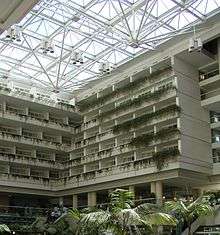
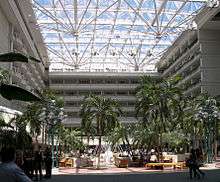
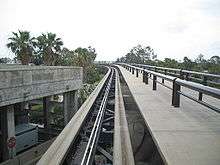
The Orlando International Airport has a hub-and-spoke layout with a large main terminal building and four airside concourses accessible via elevated people movers. The main terminal building is divided into two terminals; A and B. There are passenger check-in and baggage claim facilities on both the building's north side (Terminal A), and on the building's south side (Terminal B). Both terminals share two security checkpoints, one in the West Hall leading to Airsides 1 and 3, and another in the East Atrium, leading to Airsides 2 and 4. Unlike the similar setup used in Tampa, passengers are required to go through security before accessing the people movers.
Airsides 1 and 3, and later Airside 4, were designed by KBJ Architects,[14] while Airside 2 was designed by Hellmuth, Obata and Kassabaum, Helman Hurley Charvat Peacock Architects, and Rhodes + Brito Architects.[15] C.T. Hsu + Associates and Rhodes + Brito Architects designed renovations that were made to Airsides 1 and 3, which were completed by April 2010.[16]
Airside 4 currently serves as the airport's primary international arrivals concourse; Airside 1 also handles some international arrivals. Arriving international passengers who require immigration and/or customs clearance are processed through those checkpoints in the airside terminal where they arrive. After clearing U.S. immigration, passengers collect their baggage and clear U.S. customs. After clearing customs, international passengers must ride the people mover to the main terminal. Airside 4 provides escalator access directly from the customs hall to the people mover platform. This has eliminated the requirement for arriving international passengers to go through a security inspection between the customs area and the people mover, and as a result they now have the option of bringing their checked baggage with them on the people mover. Alternatively, passengers also have the option of placing their baggage on a transfer belt in the customs hall for transport to the main terminal's baggage claim. Passengers who are connecting to a flight in Airside 4 or clearing customs in Airside 1, as well as airport employees, will need to go through security upon exiting customs.
The airport features an on-site Hyatt Regency hotel within the main terminal structure. The hotel is located on the East Atrium side of the terminal with a fourth floor lobby level and guest rooms beginning on level five and above. The airport features an expansive lobby area for guests awaiting flights, convention space, several bars, and two restaurants including a signature restaurant on the top level of the terminal building overlooking the airport facility and runways below.
Terminal A
Major domestic carriers based in Terminal A include Alaska Airlines, JetBlue Airways, Southwest Airlines and Virgin America Major international carriers include Aer Lingus, Aeromexico, Avianca, Azul Brazilian Airlines, and WestJet.
Airside 1
- Gates 1–29
- Secondary International Arrivals Concourse
- Part of original terminal, Opened in 1981
Airlines
Airside 2
- Gates 100–129
Airlines
Terminal B
Major domestic carriers based in Terminal B include American Airlines, Delta Air Lines, Spirit and United Airlines. Major international carriers include Air Canada, Air Canada Rouge, Air Transat, British Airways, Emirates, Icelandair, LATAM Brasil, Lufthansa, Thomas Cook Airlines and Virgin Atlantic which primarily operate out of Airside 4, the airport's main international arrivals concourse.
Airside 3
- Gates 30–59
- United Airlines United Club
- Part of original terminal, opened in 1981
Airlines
Airside 4
- Gates 70–99
- Primary International Arrivals Concourse
- The Club at MCO
- Delta Air Lines Sky Club
Airlines
- Air Canada
- Air Transat
- British Airways
- Delta
- Emirates
- Frontier
- LATAM Brasil
- LATAM Perú
- Lufthansa
- Norwegian
- Sun Country
- Thomas Cook
- Virgin Atlantic
- Volaris
Notable services
Delta Air Lines was the first airline with jet flights to MCO, with their DC-8 'fanjet' 'Royal Service' flights.
Eastern Airlines 'the wings of man', became the first 'official' airline of the Walt Disney World Resort, and sponsored an attraction in their 'Tomorrowland' called: 'If You Had Wings'. Later when Eastern closed Delta took the attraction over, it was called Dream Flight.
In the early 1970s Delta, National, and Eastern Airlines began 'widebody' flights to MCO, National with the DC-10-10 and −30 and Delta and Eastern Airlines with the L-1011. Eastern had wide-body, intrastate service with L-1011 flights to Miami.
Virgin Atlantic's Boeing 747-400 is currently the largest airliner at the airport. The airline has multiple daily flights from the UK. During peak seasons, up to five Virgin Boeing 747s may be at Orlando's gates at once. British Airways competes with Virgin to London Gatwick with ten Boeing 777s a week.[17]
Lufthansa opened a shared gate in Orlando on October 30, 2007, providing the first direct flight between Orlando and a hub in continental Europe (in this case, Frankfurt, Germany) as part of an effort to diversify the local economy beyond tourism. As of late October 2009, Lufthansa expanded its five flights a week to daily between MCO and Frankfurt on Airbus A330s and Airbus A340s, with connections throughout Europe, expanding to a Boeing 747 in the winter.[18]
The Airbus A380, the world's largest airliner, landed at MCO on November 14, 2007 from Montreal. Orlando was one of the first airports in the world to be "Airbus A380 ready".
On June 7, 2011 Air France began service from Orlando to Paris-Charles De Gaulle using the Boeing 777-300ER. Service to Paris-Charles De Gaulle ended on September 2, 2012.
On July 2, 2011 Edelweiss Air flying on behalf of Swiss International Air Lines began weekly service from Orlando to Zürich Airport. The service operated on Saturdays only until mid-September.
British charter airline Thomas Cook Airlines moved its Orlando flights from Sanford Airport where they and predecessors Airtours Intl/My Travel, and JMC Air have operated since it opened. Flights commenced April 2014.
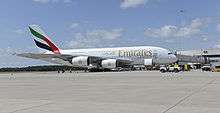
In March 2015, Emirates announced that they will begin daily service to the airport from Dubai International Airport beginning September 1, 2015.[19] The airport had tried to attract Emirates for five years before the service was announced.[20][21] Orlando International was the first airport in Florida served by Emirates. The airline expects three major markets for the flights: leisure and corporate travelers along with locals of Asian heritage traveling to Asia, which is well-served by the airline.[22] Greater Orlando Aviation Association Chair Frank Kruppenbacher called the new service "without question the biggest, most significant move forward for our airport"[21] and estimates that the local economic impact of the new service will be up to $100 million annually.[23] The inaugural flight was made with an Airbus A380. Regularly scheduled flights will operate Boeing 777-300ERs.[24][25]
On August 3, 2016, Air Berlin announced a 4 weekly service between Orlando and Düsseldorf, Germany. The flight will be operated with an Airbus A330-200.[26]
Airlines and destinations
Note: All flights to Cuba are operated as scheduled Special Authority Charters. All international arrivals (except flights with US Customs Pre-Clearance) are handled at Airside 1 and 4.
Passenger
a: Emirates's check in and baggage claim is at Terminal A but uses Airside 4, which is part of Terminal B.
b: Icelandair's check in and baggage claim is at Terminal B but uses Airside 1, which is part of Terminal A.
c: Virgin Atlantic's check in and baggage claim is at Terminal A but uses Airside 4, which is part of Terminal B.
Cargo
| Airlines | Destinations |
|---|---|
| ABX Air | Cincinnati, Miami |
| FedEx Express | Fort Lauderdale, Indianapolis, Memphis, Newark |
| FedEx Feeder operated by Mountain Air Cargo | Tallahassee |
| UPS Airlines | Dallas/Fort Worth, Louisville, Newark |
Statistics
Domestic statistics
Top destinations
| Rank | Airport | Passengers | Carriers |
|---|---|---|---|
| 1 | Atlanta, Georgia | 1,372,000 | Delta, Frontier, Southwest, Spirit |
| 2 | Philadelphia, Pennsylvania | 826,000 | American, Frontier, Southwest, US Airways |
| 3 | Newark, New Jersey | 757,000 | JetBlue, Southwest, United |
| 4 | New York–JFK, New York | 744,000 | American, Delta, JetBlue |
| 5 | Chicago–O'Hare, Illinois | 738,000 | American, Frontier, Spirit, United |
| 6 | Dallas/Fort Worth, Texas | 589,000 | American, Spirit |
| 7 | Detroit, Michigan | 578,000 | Delta, Frontier, Southwest, Spirit |
| 8 | New York–LaGuardia, New York | 540,000 | American, Delta, JetBlue |
| 9 | Denver, Colorado | 523,000 | Frontier, Southwest, United |
| 10 | Charlotte, North Carolina | 513,000 | American/US Airways |
Airline market share
| Rank | Airline | Passengers | Share |
|---|---|---|---|
| 1 | Southwest Airlines | 10,245,000 | 29.74% |
| 2 | American Airlines | 5,645,000 | 16.38% |
| 3 | Delta Air Lines | 5,522,000 | 16.03% |
| 4 | JetBlue | 4,732,000 | 13.74% |
| 5 | United Airlines | 3,648,000 | 10.59% |
| 6 | Others | 4,662,000 | 13.53% |
International statistics
Orlando International Airport was the 14th largest international gateway in the United States and second largest in Florida (behind Miami International Airport) for the year ending June 2013. The airport handled 3,694,774 arrivals on international flights during that period, of which 82.9% were carried by a foreign airline and 17.1% by a domestic airline.[45]
Top destinations
| Rank | City | Passengers | Top carriers |
|---|---|---|---|
| 1 | São Paulo (Guarulhos), Brazil | 977,850 | TAM, Delta |
| 2 | Toronto (Pearson), Canada | 950,611 | Air Canada, Air Canada Rouge, Air Transat, Sunwing, WestJet |
| 3 | Panama City, Panama | 870,390 | Copa Airlines |
| 4 | Bogotá, Colombia | 713,389 | Avianca, LAN Colombia |
| 5 | London (Gatwick), United Kingdom | 677,193 | British Airways, Virgin Atlantic Airways |
| 6 | Mexico City, Mexico | 616,437 | Aeromexico, Volaris |
| 7 | Santo Domingo, Dominican Republic | 524,962 | JetBlue, GOL |
| 8 | Cancún, Mexico | 450,904 | Delta, JetBlue |
| 9 | Nassau, Bahamas | 423,303 | Bahamasair, JetBlue |
| 10 | Manchester, United Kingdom | 421,997 | Virgin Atlantic, Thomas Cook |
Airline market share
| Rank | Airline | Passengers 2014/2015 |
Change | Destinations |
|---|---|---|---|---|
| 1 | Virgin Atlantic Airways | 14: 824,789 15: 820,688 |
|
London–Gatwick, Manchester (UK)
Seasonal: Belfast-International, Glasgow–International |
| 2 | Air Canada1 | 14: 521,427 15: 571,336 |
|
Montréal–Trudeau, Ottawa, Toronto–Pearson
Seasonal: Halifax |
| 3 | Copa Airlines | 14: 354,359 15: 386,291 |
|
Panama City |
| 4 | TAM Airlines | 14: 281,833 15: 338,123 |
|
Brasília, São Paulo–Guarulhos |
| 5 | WestJet | 14: 325,247 15: 337,068 |
|
Calgary, Toronto–Pearson
Seasonal: Charlottetown, Edmonton, Halifax, Hamilton (ON), Kitchener–Waterloo, London (ON), Moncton, Montréal–Trudeau, Ottawa, St. John's, Vancouver, Winnipeg |
| 6 | British Airways | 14: 264,579 15: 291,673 |
|
London–Gatwick |
| 7 | Lufthansa | 14: 203,559 15: 232,162 |
|
Frankfurt |
| 8 | Aeroméxico | 14: 156,498 15: 198,871 |
|
Mexico City |
| 9 | Azul Brazilian Airlines | 14: 7,743 15: 194,609 |
|
Campinas |
| 10 | Thomas Cook Airlines | 14: 104,291 15: 141,825 |
|
Seasonal: Belfast–International, Cardiff, Glasgow–International, London–Gatwick, London–Stansted, Manchester (UK) |
- ^1 Includes Air Canada Rouge
Airline lounges
- Delta Air Lines Sky Club: Located in Airside 4 on the 2nd floor of the center atrium.[48]
- United Airlines United Club: Located near Gate 43 in Airside 3.[49]
- American Airlines Admirals Club: Coming in 2016[50]
- The Club at MCO: Located near Gate 91 in Airside 4[51]
Terminal expansions and renovations
Airside terminals 1 and 3, both of which opened in 1981, recently underwent major renovations designed by architects C.T. Hsu + Associates.[16] The new terminal designs incorporate modern architectural features that includes new skylights and expanded concession areas. In addition, the mechanical and electrical systems were completely overhauled in each terminal. The project was completed in both terminals in 2010. In 2012, British Airways announced the opening of a 'shared lounge' in Airside 4.
Rental Car Quick Turnaround Facility
Two state of the art car rental facilities were recently completed on both the north side Terminal A and south side Terminal B. Select car rental agencies currently operate on-site car rental pickup in the ground level of the main parking garages. The new facilities has relocated the car rental pickup process to the new facilities and has allowed additional space for off-site agencies to relocate to the on-site airport facilities.
South Airport Intermodal Terminal
The South Airport Intermodal Terminal is currently under construction approximately one mile due south of the main airport terminal. The new station, which is partially being funded by the Florida Department of Transportation, will serve as the Orlando station for the Brightline higher speed regional rail service, which will connect Orlando International Airport to downtown Miami via the Florida East Coast Railway.[52] The station, which will be connected to the main terminal via an automated people mover (APM) system, is mostly reusing plans from the original Florida High Speed Rail Orlando Airport station, which would have been northern terminus of the initial Orlando-Tampa route along the Interstate 4 corridor. However, on February 16, 2011, Florida Governor Rick Scott formally announced that he would be rejecting federal funds and effectively killing the Florida High Speed Rail project. The airport authority had already invested considerably to accommodate the station and high-speed rail line, such as the extra length of the south taxiway bridges over the southern airport access road (which will now be used by Brightline).[53] As part of the estimated $684 million price tag for the intermodal terminal complex,[52] the airport authority is also building a new 2,500 space parking garage.
A future connection to the SunRail commuter rail service is also being explored. The 5.5 mile route currently under consideration would travel 3.5 miles from the existing SunRail line along a Orlando Utilities Commission (OUC) rail spur, which runs along the southern boundary of the airport's property and is used exclusively by coal trains to serve the Curtis H. Stanton Energy Center in eastern Orange County. From there, two options are currently under consideration; one plan would have SunRail trains branch north off of the existing OUC line and onto a new 2-mile spur that would terminate at the planned South Airport Intermodal Terminal. The second option being explored would be to build a transfer station along the OUC line where passengers would transfer from SunRail trains onto light rail trains that would run along a dedicated 2-mile line between the transfer and airport stations.[54][55]
In addition to Brightline and SunRail, the station will also serve one of two proposed rail connections to International Drive. The first option being considered is an elevated maglev train system that would be built by American Maglev Technology, which would connect the airport to the Orange County Convention Center, the Florida Mall, and the Sand Lake Road SunRail station.[56][57] A second option being explored would be a light rail line that would most likely run along a similar route as the maglev alternative between the airport and International Drive.[58]
South Terminal Complex
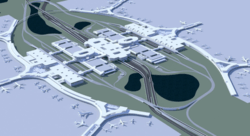
In May 2015, the Board of the Greater Orlando Aviation Authority (GOAA) voted unanimously to approve construction of the $1.8 billion South Terminal Complex (STC), which will be located directly south of the existing terminal.[59] The STC will be built adjacent to the South Airport Intermodal Terminal, which is currently under construction, and both will be connected to the existing terminal via a new Automated People Mover (APM).[60] Phase I (which will be known as "Terminal C") will encompass approximately 300 acres and will include new aircraft taxiways and aprons, a 2.7 million square foot terminal building with 16-24 gates, and a 6-story 5,000 space parking garage. Construction of the STC is expected to begin sometime in 2017 and will be operational by 2019.[61]
Transportation
The Orlando International Airport is a major transportation hub for the Central Florida region and provides various ground transportation options including public transit, private transportation, and car rental.
Lynx
Lynx, the local metro area public transportation system operates a sub-station at the airport with public bus service to Downtown Orlando and other area routes.
Disney's Magical Express
A complimentary motor coach transportation service to all twenty four Walt Disney World resort hotels. The motor coach service is operated by Mears Transportation and is available to Disney guests with resort reservations. An agreement with BAGS Incorporated also provides checked luggage pickup and delivery system for Disney guests utilizing the Disney's Magical Express service.
Cruiseline transportation
The airport serves as a major inbound gateway for cruise line passengers departing out of Port Canaveral on lines including Royal Caribbean International, Carnival Cruise Lines, Disney Cruise Line, SunCruz Casinos, and Sterling Casinos, all operating motorcoach transportation to Port Canaveral, primarily with partnerships with Mears Transportation.
Taxis/Shuttles
Taxi cab service is available via a taxi stand line on the Ground Transportation level of both terminals, airport licensed cab companies include Yellow Cab, Star Taxi, Diamond, Ace, Town & County. Share transportation is not permitted by Orlando City. Airport shuttle transportation services include Super Shuttle, Mears Transportation, and other private transportation companies. The community of The Villages in Sumter, Lake, and Marion has shuttles operating between the community and Orlando International Airport. These services include Village Airport Van, The Villages Transportation, and A-1 Taxi among others.
Helipad and Other
A de facto helipad, referred to by GOAA as a "helistop" in view of its limited facilities, is located on the top level of the terminal top parking garage and is available landing space with proper clearance for private transportation via helicopter. It is often used for transportation of high-profile celebrities and business executives to and from the airport.
See also
- McCoy Air Force Base
- Strategic Air Command
- B-52 Memorial Park
- Florida World War II Army Airfields
- Innovation Way
- World's busiest airports by passenger traffic
References
- 1 2 http://www.orlandoairports.net/statistics/monthly/trfccy2015.pdf
- ↑ FAA Airport Master Record for MCO (Form 5010 PDF), effective March 15, 2007
- ↑ "ACI passenger figures in 2007". Airports Council International. August 1, 2011. Archived from the original on September 29, 2007. Retrieved November 21, 2011.
- ↑ "Traffic Statistics". Greater Orlando Aviation Authority. January 2016. Retrieved July 10, 2016.
- ↑ "Great Circle Mapper: MCO / KMCO – Orlando, Florida". Karl L. Swartz. Retrieved November 21, 2011.
- ↑ GOAA. "Orlando International Breaks Through The 40 Million Passenger Mark With April Traffic Numbers - Orlando International Aiport (MCO)". Orlando International Airport.
- ↑ Northwest Florida Regional Airport
- ↑ Wichita Falls Municipal Airport
- ↑ The Quick Ref OAGs for 1 Nov and 15 Nov show a couple of Delta 880s at ORL, with no mention of MCO, but that's presumably a mistake. The 1 Dec shows them at MCO.
- ↑ "Orlando's $250 Million Airport Giant-Size People Movers". Sarasota Herald-Tribune. 1980-01-20. Retrieved 2014-06-28.
- ↑ Pike, John (July 21, 2011). "Space Shuttle Emergency Landing Sites". Global Security. Retrieved November 21, 2011.
- ↑ "JetBlue Plans New Focus City at Orlando International Airport" (Press release). JetBlue Airways. March 19, 2008. Retrieved July 8, 2013.
- ↑ Kassab, Beth (May 26, 2006). "Original Orlando Terminal Reduced To Rubble". Orlando Sentinel. Retrieved June 26, 2009.
- ↑ "Aviation List". KBJ Architects. Retrieved June 25, 2012.
- ↑ Hanuschak, Blair; Moe, Don (February 2, 2002). "Spanning the Sky" (PDF). Modern Steel Construction. Retrieved June 25, 2012.
- 1 2 "Orlando International Airport Airsides 1 & 3 Expansion". C.T. Hsu + Associates. Retrieved June 25, 2012.
- ↑ Maxon, Terry (September 20, 2007). "Slots fort Heathrow". Airline Biz. Archived from the original on November 11, 2007. Retrieved November 21, 2011.
- ↑ Garcia, Jason (October 29, 2007). "Area Hopes for Image Upgrade in Lufthansa's New Direct Flights". Orlando Sentinel. Retrieved November 21, 2011.
- ↑ "Emirates Announces a New Daily Service to Orlando". Emirates. Retrieved 20 June 2015.
- ↑ Mouawad, Jad (March 16, 2015). "Expansion by Mideast Airlines Sets Off a Skirmish in the U.S.". The New York Times. Retrieved 20 June 2015.
[Philip Brown, the director of OIA] has been trying to lure Emirates to Orlando for the last five years
- 1 2 Ober, Amanda (24 March 2015). "OIA announces nonstop service to Dubai on Emirates Airlines". WESH 2. Retrieved 20 June 2015.
- ↑ Werley, Jensen (2 June 2015). "Private pods, five course meals: Why Emirates' Orlando service will bring high-end flying to Jacksonville travelers". Jacksonville Business Journal. Retrieved 20 June 2015.
- ↑ Barnes, Susan (2 September 2015). "Emirates touches down in Orlando, shows off its Airbus A380 superjumbo". USA Today. Retrieved 2 September 2015.
The estimated economic impact of the new daily flight from Dubai to Orlando is upwards of $100 million annually, according to Frank Kruppenbacher, chairman of the Greater Orlando Aviation Authority.
- ↑ EricaRakow (September 1, 2015). "Inaugural @emirates flight from Dubai to Orlando just landed! This begins daily non-stop service to/from MCO -> DXB" (Tweet) – via Twitter.
- ↑ "EK219 Flight history". Flightradar24. Retrieved 1 September 2015.
- ↑
- ↑ aero.de - "Air Berlin with significantly more US flights in summer 2017" (German) 2 August 2016
- ↑ Airlines, Alaska. "Alaska Airlines Announces New Flying Between Portland, Oregon, and Orlando, Florida". PR Newswire.
- ↑ 2016, UBM (UK) Ltd. "Alaska Resumes Portland OR – Orlando Service from March 2017". routesonline.
- ↑ http://www.routesonline.com/news/38/airlineroute/268729/azul-adds-new-orlando-route-from-dec-2016/
- ↑ "Delta adds Orlando – St. Louis route from Feb 2017". routesonline. Retrieved 31 October 2016.
- ↑ https://www.eurowings.com/en/booking/offers/flights-from/DE/CGN/to/US/SEA/2017-7.html
- ↑ https://www.denverpost.com/2016/06/29/frontier-airlines-nonstop-orlando-colorado-springs/
- ↑ http://whotv.com/2016/07/20/frontier-airlines-adds-non-stop-orlando-flights-from-des-moines/
- ↑ http://www.aviationpros.com/press_release/12243472/frontier-airlines-resumes-msn-mco-service
- ↑ http://www.routesonline.com/news/38/airlineroute/268041/frontier-adds-new-pair-of-orlando-routes-from-late-oct-2016/
- ↑ http://www.bradenton.com/news/business/article109359182.html
- ↑ http://www.usatoday.com/story/travel/flights/todayinthesky/2016/09/26/jetblue-adds-new-cross-country-route-los-angeles/91114750/
- ↑ Liu, Jim (30 August 2016). "LATAM Chile resumes Orlando seasonal service in 1Q17". Airline Route. Retrieved 29 August 2016.
- ↑ http://www.routesonline.com/news/38/airlineroute/270067/norwegian-expands-paris-us-flights-from-july-2017/
- ↑ Loreno, Darcie (July 26, 2016). "Spirit Airlines expanding to Akron-Canton Airport". WJW (TV). Retrieved July 26, 2016.
- 1 2 3 http://www.nasdaq.com/press-release/high-five-orlando-spirit-airlines-brings-a-handful-of-new-destinations-to-the-theme-park-capital-o-20160721-00808
- ↑ https://www.thomascookairlines.com/en/cheap-flights/usa/orlando/from-birmingham/
- 1 2 "Orlando, FL: Orlando International (MCO)". Bureau of Transportation Statistics. Retrieved June 20, 2016.
- ↑ "U.S. International Air Passenger and Freight Statistics: June 2013" (PDF). dot.gov. U.S. Department of Transportation, Office of the Assistant Secretary for Aviation and International Affairs. October 2013. p. 36. Archived from the original (PDF) on January 10, 2014. Retrieved 8 August 2014.
- ↑ "U.S.-International Passenger Raw Data for Calendar Year 2014". United States Department of Transportation. December 2014. Retrieved February 13, 2016.
- ↑ http://www.orlandoairports.net/statistics/monthly/paxsfy2015.pdf
- ↑ "Delta Airlines Orlando Airport".
- ↑ "United Club Locations".
- ↑ "American Airlines Re-Imagines Lounge Experience".
- ↑ "The Club Airport Lounges". www.theclubairportlounges.com. Retrieved 14 January 2016.
- 1 2 "Orlando Int'l Airport to become transportation hub with new...". WFTV.
- ↑ "Florida High Speed Rail Industry Forum" (PDF). Florida High Speed Rail. December 2, 2009. Archived from the original (PDF) on March 27, 2010. Retrieved November 21, 2011.
- ↑ "SunRail will not link with Orlando International Airport for five or more years - Orlando Sentinel". Articles.orlandosentinel.com. 2013-11-16. Retrieved 2015-03-03.
- ↑ "SunRail link to Orlando airport gets closer look". Orlando Sentinel. 2015-10-30. Retrieved 2015-11-05.
- ↑ Jacim, Tracy (18 March 2015). "Orlando's maglev train a step closer to reality". Fox 35 News Orlando. Archived from the original on March 22, 2015. Retrieved 23 March 2015.
- ↑ "Maglev-train plan for airport, convention center back on track". Orlando Sentinel. 2015-03-05. Retrieved 2015-05-05.
- ↑ "Orlando airport board opts to pursue right-of-way". Orlando Sentinel. 2015-12-09. Retrieved 2016-04-01.
- ↑ Synan, Michael (20 May 2015). "Nearly $2B for new OIA terminal". MyFoxOrlando.com. Retrieved 20 June 2015.
- ↑ Tracy, Dan (September 6, 2015). "Construction booming at Orlando International Airport". Orlando Sentinel.
- ↑ "GOAA Board Approves Plan to Build New South Terminal at Orlando International Airport". Greater Orlando Aviation Authority. 2016-03-16. Retrieved 2016-04-01.
External links
| Wikimedia Commons has media related to Orlando International Airport. |
| Wikivoyage has a travel guide for Orlando International Airport. |
- Official website
- FAA Airport Diagram (PDF), effective November 10, 2016
- Resources for this airport:
- AirNav airport information for KMCO
- ASN accident history for MCO
- FlightAware airport information and live flight tracker
- NOAA/NWS latest weather observations
- SkyVector aeronautical chart for KMCO
- FAA current MCO delay information
